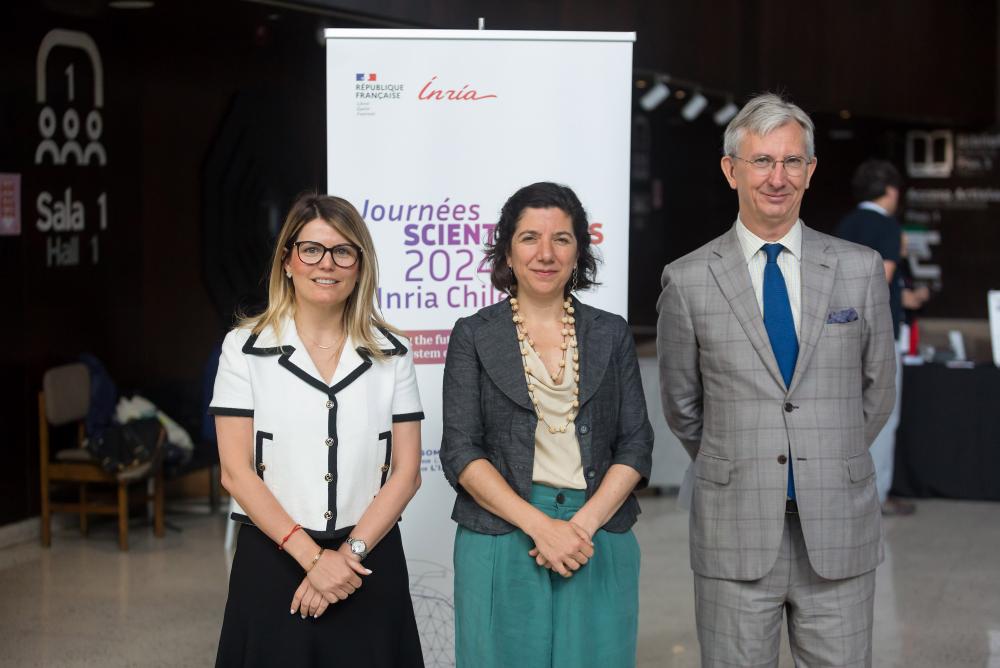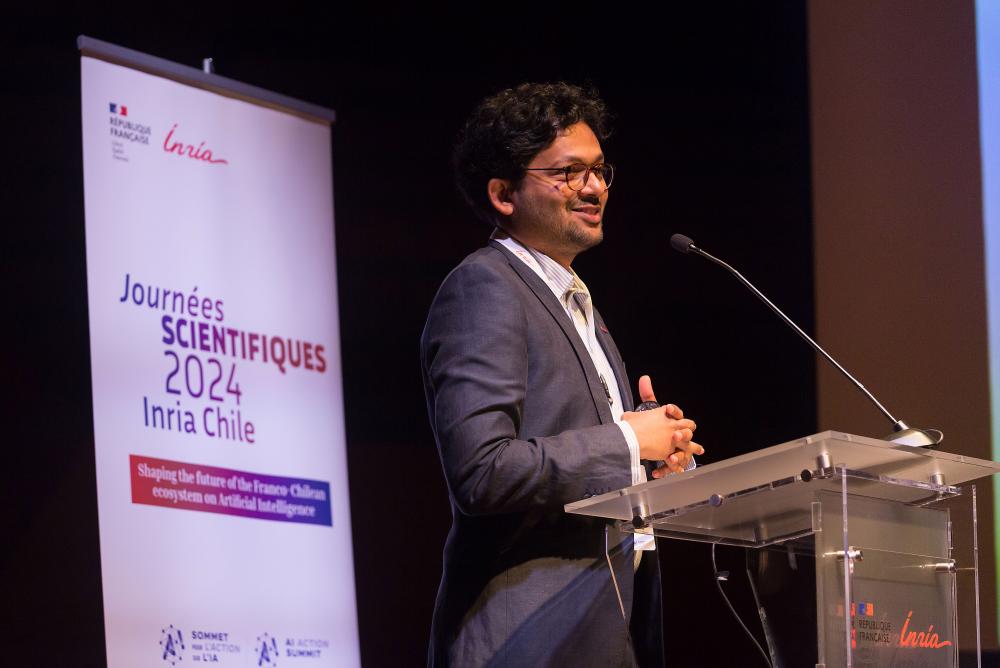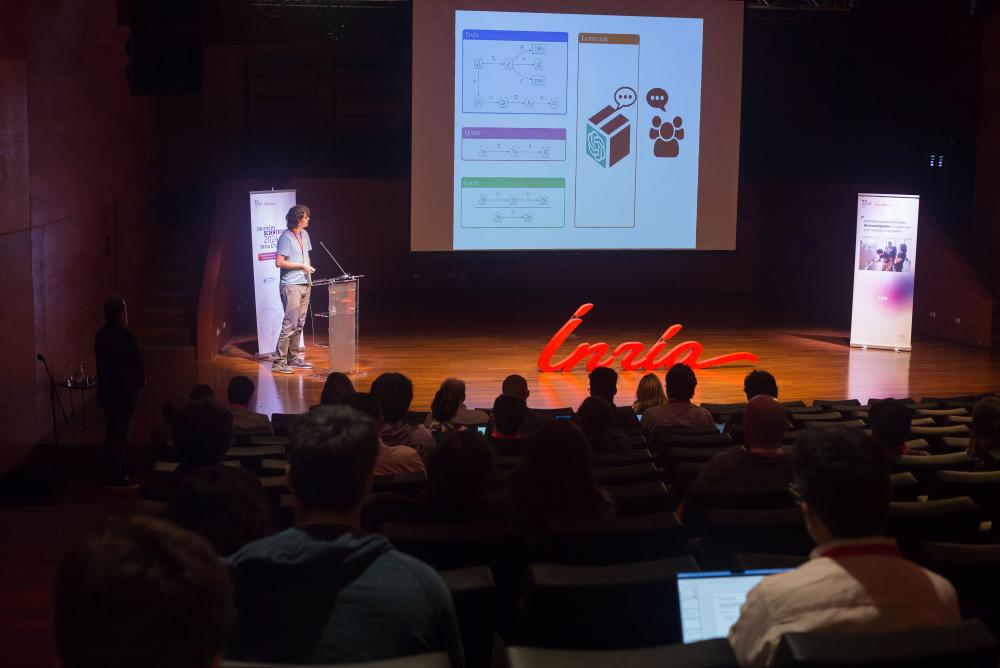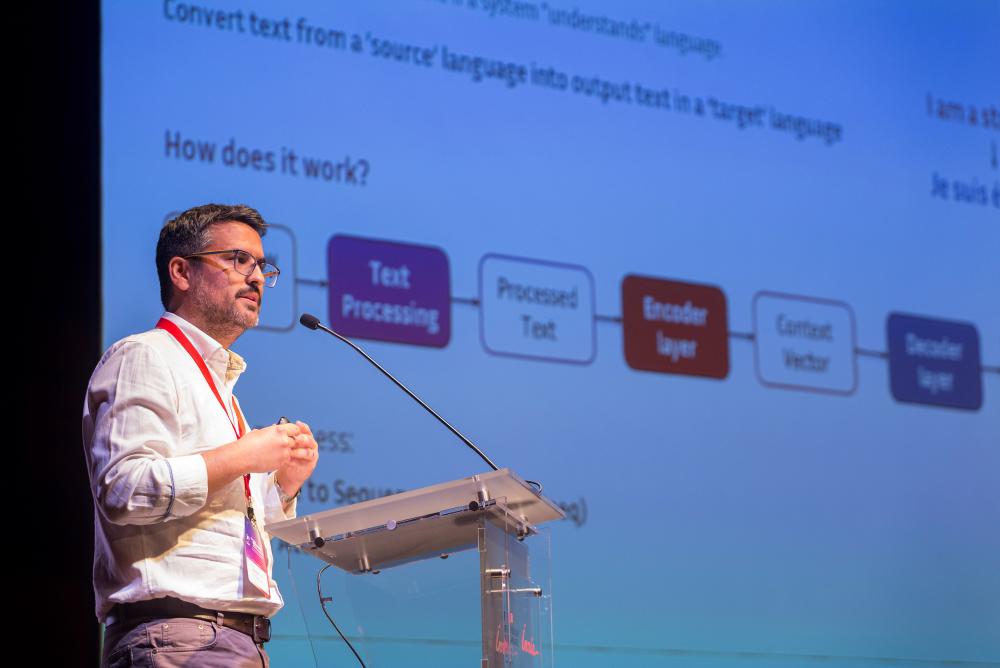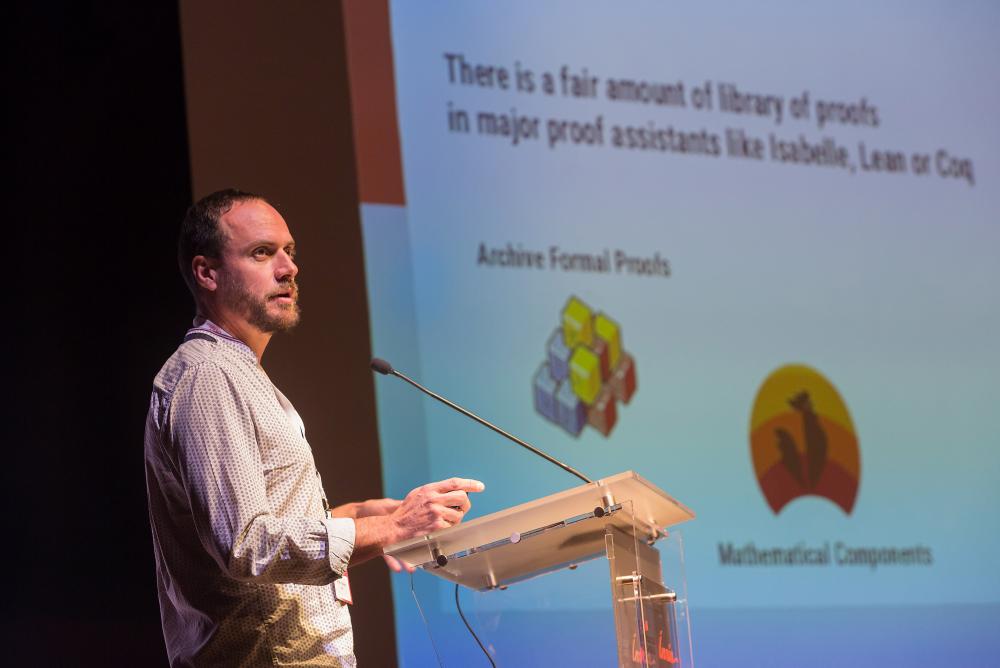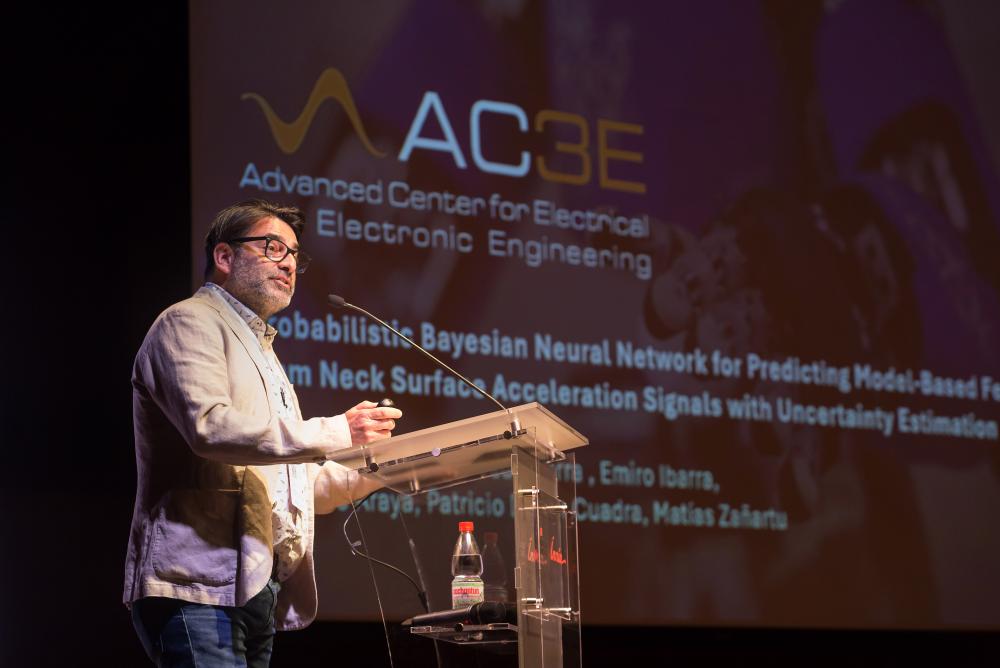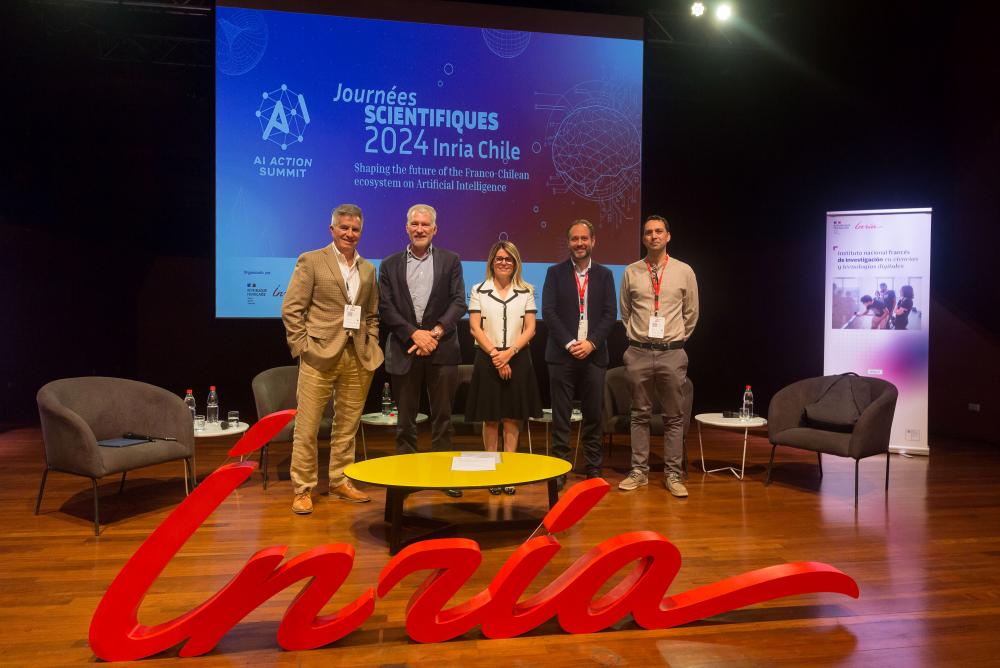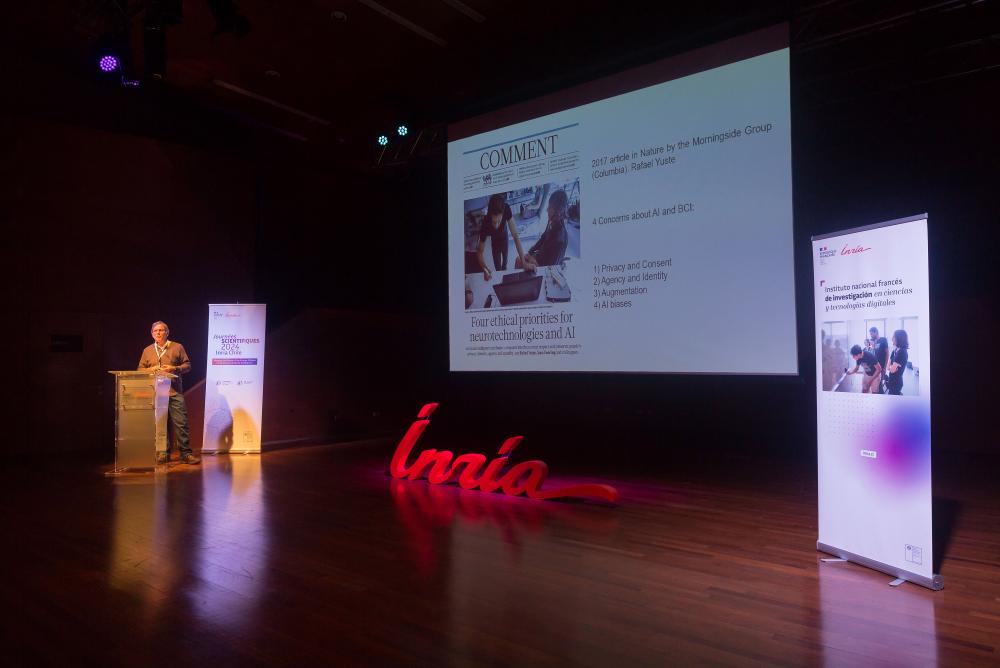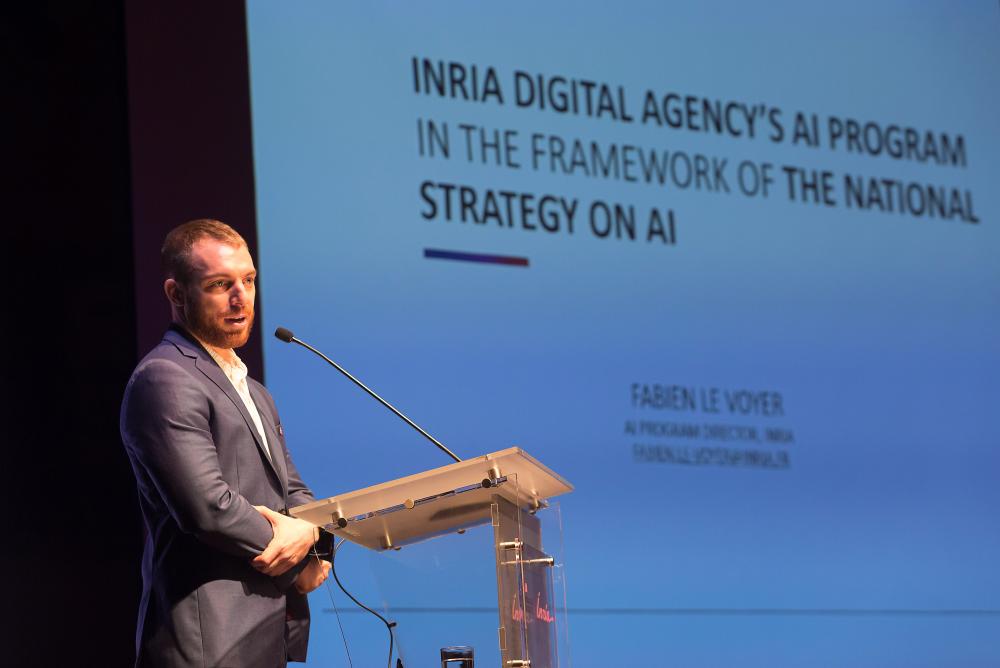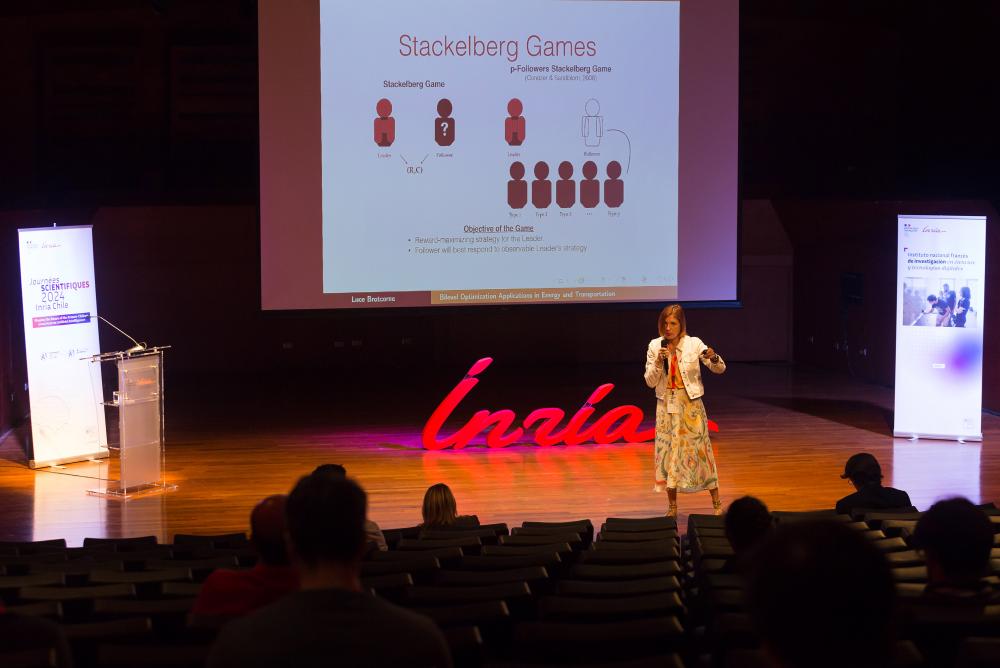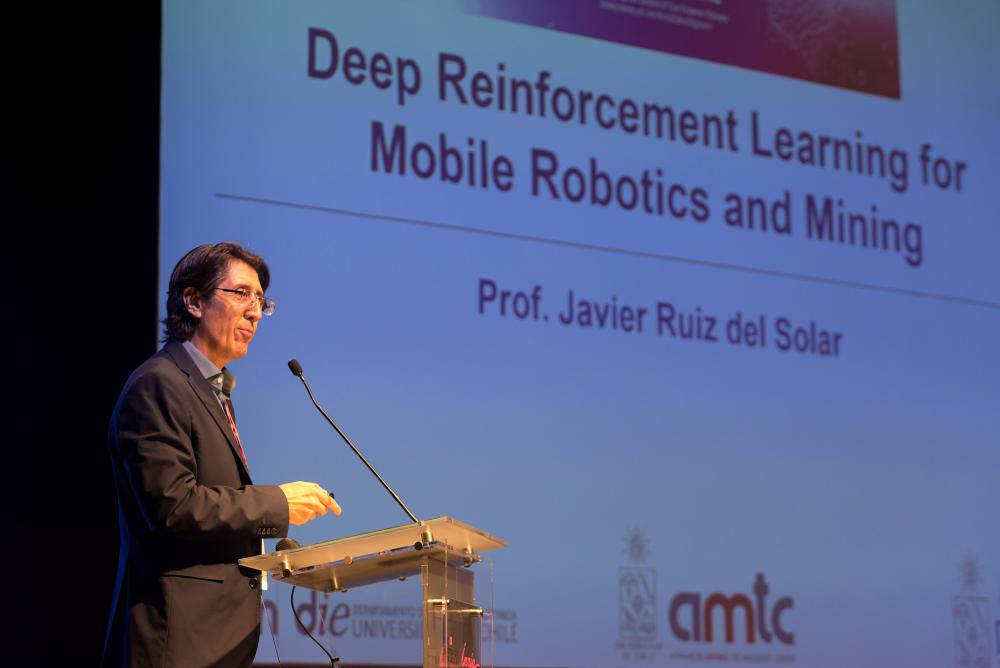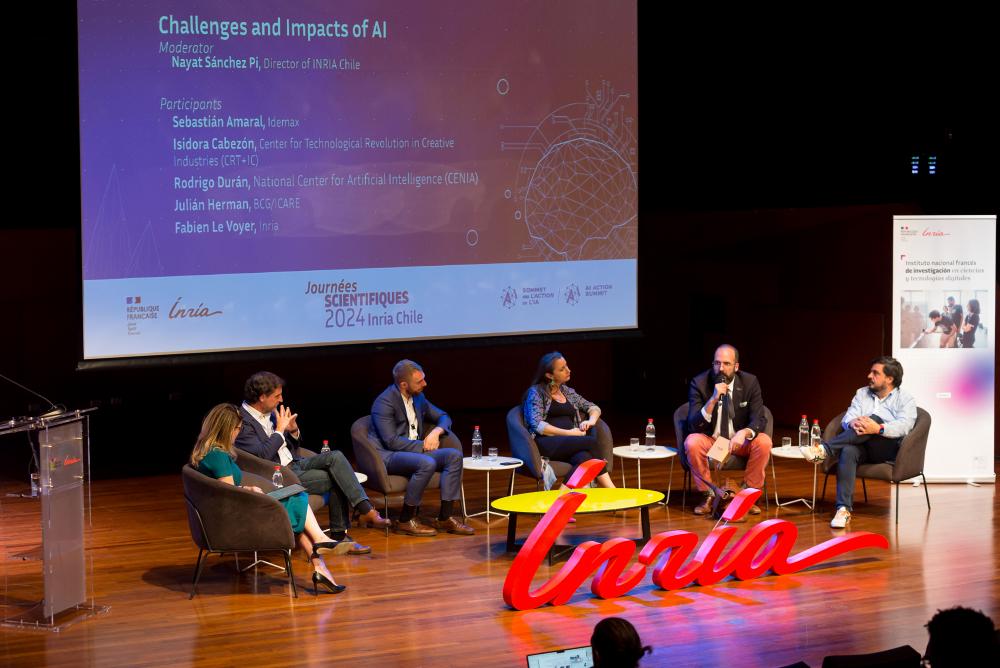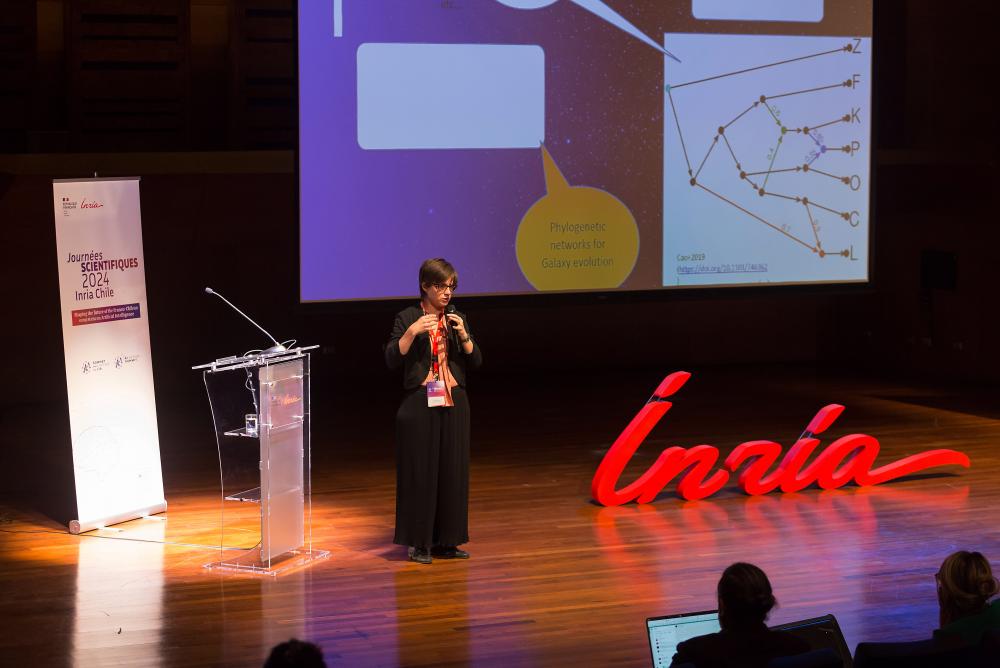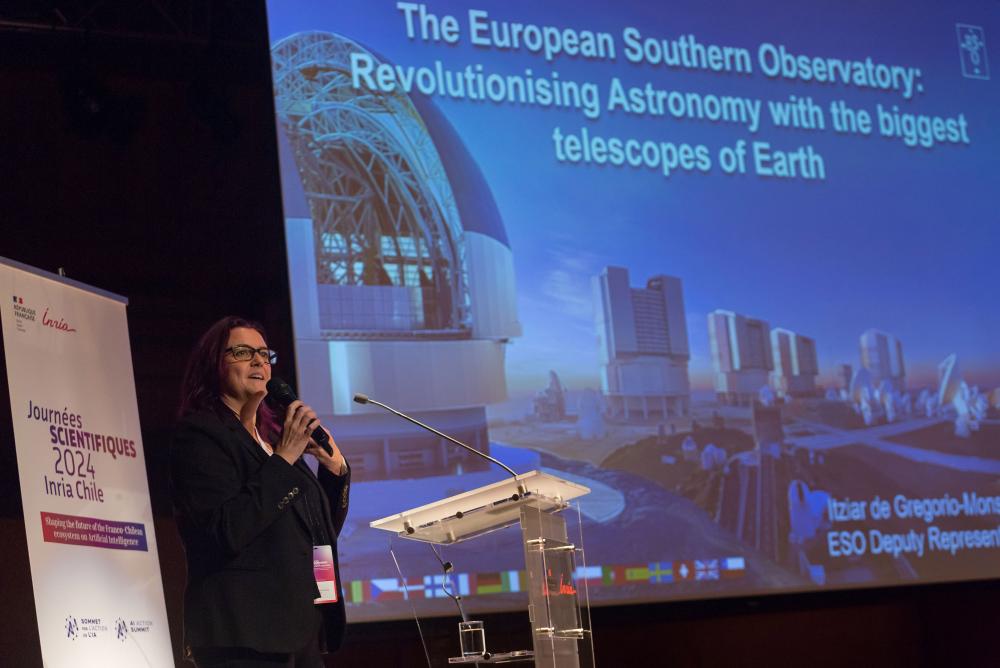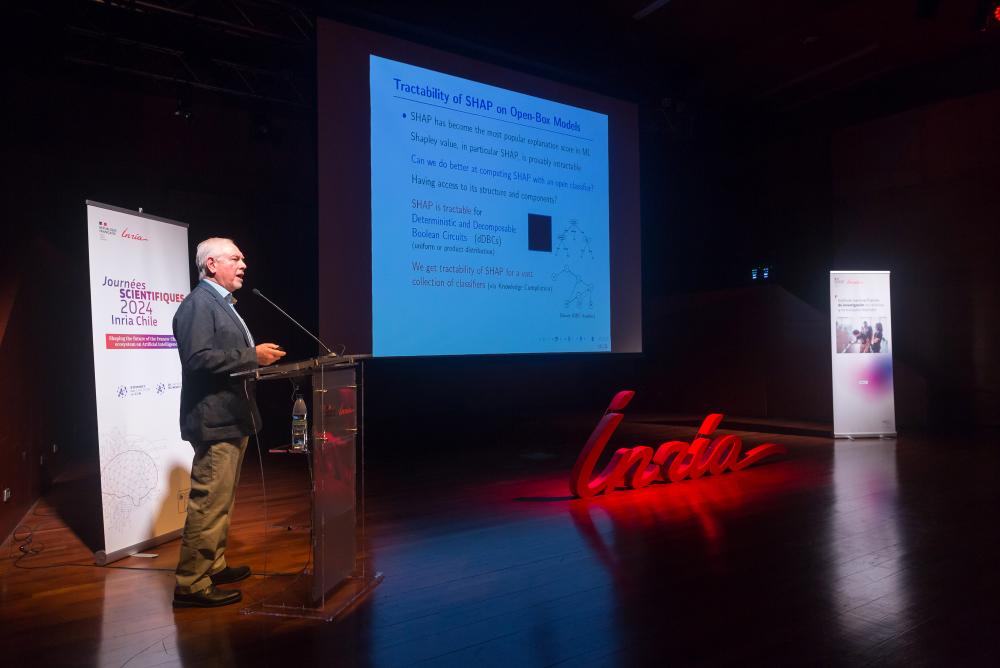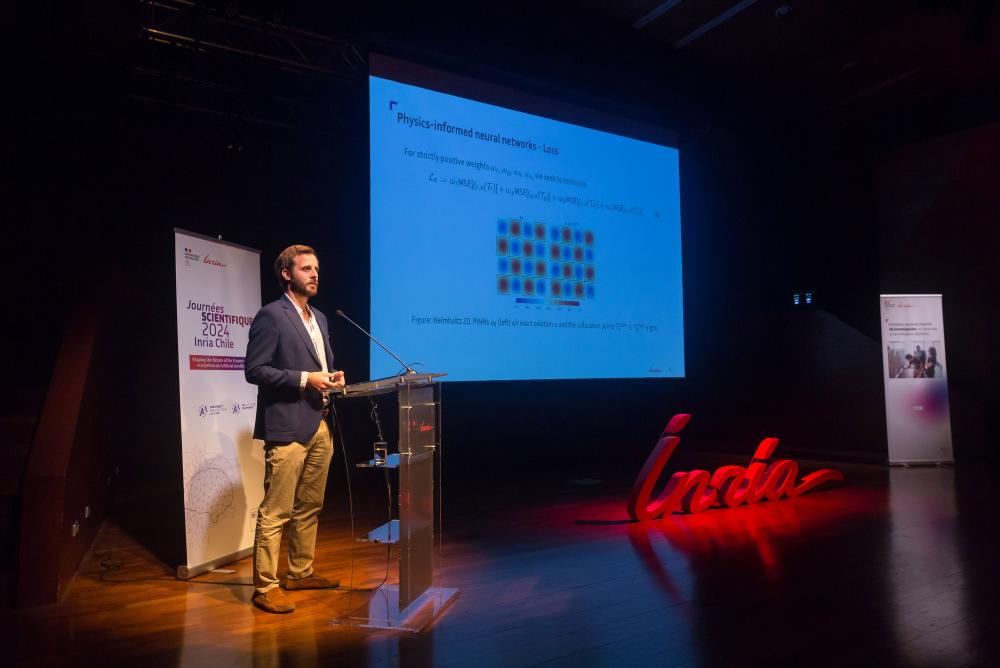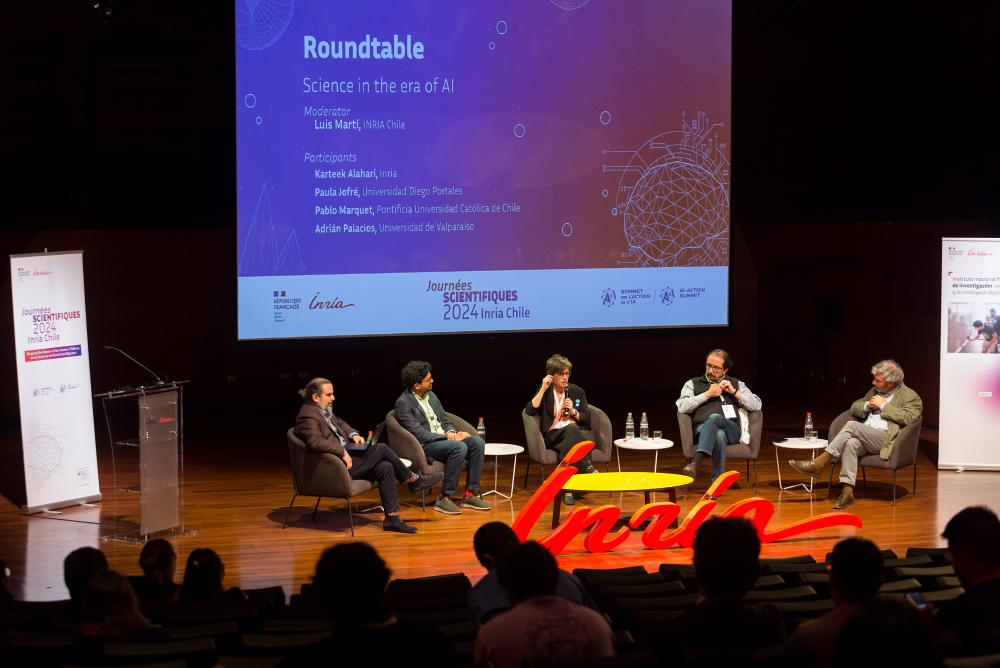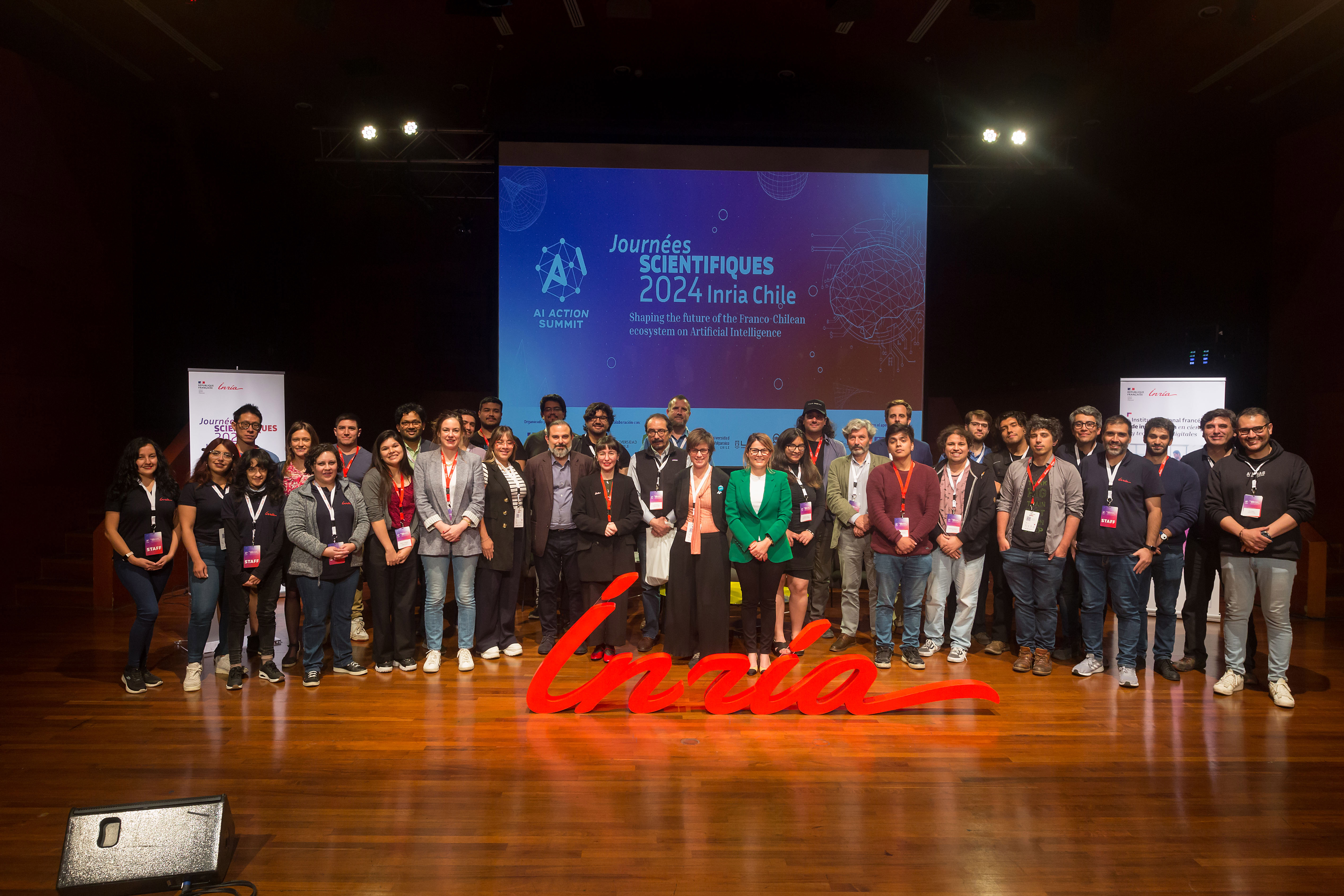
As the first official event of Inria Chile after the signing of the Agreement for the creation of the Franco-Chilean Binational Center on AI, the third edition of the Journées Scientifiques Inria Chile was held at the Centro Cultural Gabriela Mistral (GAM): Shaping the future of the Franco-Chilean Ecosystem on Artificial Intelligence, a bridging event towards the AI Action Summit.
The event represented a unique opportunity in which French and Chilean researchers and representatives of the French-Chilean AI ecosystem met to address the complex challenges and opportunities in artificial intelligence (AI) around current issues:
-
Generative AI and foundational models
-
Advances in AI
-
AI and Public Interest
-
Uses of AI
-
AI for Science
During the three days, participants attended talks by renowned scientists, listened to public and private sector representatives from Chile and France at round tables, and were able to share experiences and ideas, with panels on:
-
The challenge of infrastructure for artificial intelligence, particularly in Latin America and Chile.
-
The Challenges and Impacts of AI, in regulation, innovation, culture, future of work and environment.
-
The revolution that Science and research are undergoing, as a result of the development of AI.
The event was inaugurated on December 4, 2024 by Nayat Sanchez-Pi, CEO of Inria Chile; the French Ambassador to Chile, Cyrille Rogeau; the Chilean Minister of Science, Technology, Knowledge and Innovation, Aisén Etcheverry; and the President and CEO of Inria, Bruno Sportisse.
© José Miguel Rojas / Inria Chile
Verbatim
The Jornadas Científicas 2024 were aligned with the thematic axes of the Paris summit in February, which allowed us to capture and make visible the most outstanding deliverables of the ecosystem. Its importance was key not only in its connection with the recent binational agreement signed a few weeks ago, but also in being the only officially recognized pre-event in Chile before the summit in 2025. The results obtained here serve as preparation for Paris, consolidating the participation of the Franco-Chilean ecosystem, especially the Chilean one, thanks to a broad call that includes the academic and innovation sector.
Director of Inria Chile
Verbatim
We live in very special, complex and, at times, disturbing times. These are times in which science denialism, which seemed to have been eradicated, is gaining strength again. Times in which the value of scientific evidence and international discussion are being questioned by leaders in different parts of the world. As a government, and I would dare to say as a country, we are rebelling against this trend. We believe that, through intellectually honest discussion, the creation of collective knowledge and the work of scientists, it is possible and necessary to build a world based on democratic principles and respect for human rights.
Minister of Science, Technology, Knowledge and Innovation of Chile
What is the AI Action Summit?
On February 10 and 11, 2025, France will host the AI Action Summit, bringing together heads of state and government, leaders of international organizations, small and large companies, representatives of academia, researchers, non-governmental organizations, artists and other members of civil society at the Grand Palais in Paris. A large number of countries, including Chile, and sectors will be represented to make this summit as inclusive as possible.
The Summit will focus on concrete actions to ensure that the development and implementation of AI benefits our societies, economies and environment, is in the general interest and respects the common good. The summit will organize its reflections and preparatory work around five main axes:
-
AI and the public interest
-
Future of work
-
Innovation and culture
-
Trusted AI
-
Global Governance of AI
Discussions will also address cross-cutting issues such as gender equality and the environmental impact of AI.
To learn more about the Summit of which the Journées Scientifiques Inria Chile 2024 is an official pre-event, go to the event page: AI Action Summit .
The scientific challenges around AI from Inria
Karteek Alahari, Deputy Scientific Director in charge of Artificial Intelligence at Inria, kicked off the Journées Scientifiques 2024 with the opening keynote.
With an overview of the research activities in artificial intelligence carried out by Inria's project-teams today, he highlighted the current scientific challenges and the work being done in machine learning, visual understanding, robotics and autonomous vehicles, natural language processing, large language models (NLP/LLMs), generative artificial intelligence, cognition and neuroscience, reliability and trustworthiness, knowledge representation, semantic web, data science and optimization. “At Inria, we have an estimate that there are about 2/3 of the 228 teams-projects that are in some way linked to AI. And there are many of them that contribute to improving tools. For example, teams dedicated to work on topics such as machine learning, on image processing and teams in robotics that are linked to AI topics. In short, our teams work on machine learning, imaging and vision, audio, robotics, neuroscience, NLP/LLMs, social, semantic web, knowledge representation, data science, optimization and statistics,” explained Karteek Alahari.
© José Miguel Rojas / Inria Chile
Exploring disruptive advances in AI
Session 1.1 “Generative AI and Foundation Models”, moderated by Luis Martí, Scientific Director of Inria Chile, was dedicated to generative artificial intelligence and the foundational models of the discipline.
In particular, the talk by Cristobal Guzmán (Pontificia Universidad Católica de Chile) covered the topics of privacy risks in machine learning (ML), differential privacy, and optimization and acceleration techniques for ML, in addition to presenting his FOAM Associate Team, which he leads together with the SIERRA project-team of the Inria Center in Paris.
Aidan Hogan (Universidad de Chile / Instituto Milenio Fundamentos de los Datos, IMFD), made a comparison between Large Language Models (LLM), knowledge graphs and search engines, their weaknesses, strengths, and hallucinations, to encourage research at the crossroads of these three complementary techniques.
Artificial intelligence biases were also addressed by Valentin Barrière (Universidad de Chile / National Center for Artificial Intelligence, CENIA), who presented a new method for bias detection in generative artificial intelligence. The researcher showed that using names as proxies allows detecting bias related to a country in LLMs; that the bias of a multilingual model depends on the language of the sentence (AI xenophobia); and that biases are linked to perplexity and are connected to the data used for pre-training, but that this does not fully explain the negative bias. Indeed, biases can be due to low correlation relationships and generative models are also useful to create data and reduce them.
Hernán Lira (Inria Chile) presented the HUEMUL project, a Spanish-Mapudungún translator that uses transfer learning for low-income languages.
© José Miguel Rojas / Inria Chile
© José Miguel Rojas / Inria Chile
Driving progress in AI development milestones
In the afternoon, in session 1.2. moderated by Pablo Barceló (Pontificia Universidad Católica de Chile / CENIA), “Breakthroughs in AI”, it was the turn of Cristián Buc, head of the research team at the National Center for Artificial Intelligence (CENIA) who explored in the second keynote of the day how cognitive neuroscience, specifically cognitive control, can inspire advances in AI. He highlighted research addressing problems such as catastrophic forgetting and the ability of machines to generalize to new contexts.
Concluding his presentation, Cristián Buc indicated, “there is value in looking at neuroscience and not necessarily at a very detailed level. There are functional levels in neuroscience that are very useful for building smarter machines and as simple as adding a task abstraction layer, which can structure information in a backbone model and then be used across gradients to recompose that information in order to adapt to a new task.”
A new application of a Probabilistic Bayesian Neural Network (PBNN) to estimate vocal function variables, improving non-invasive ambulatory voice monitoring, was the central work presented by Matías Zañartu (Universidad Técnica Federico Santa María / Advanced Center for Electrical and Electronic Engineering, AC3E), while Elizabeth Montero (Universidad Técnica Federico Santa María) presented her research on the automatic design of metaheuristic algorithms with learning.
Nicolas Tabareau (GALLINETTE project team of the Inria center of the Université de Rennes) stressed the importance of combining the rigor of Interactive Theorem Provers (ITP) with the automation capabilities of LLMs, as a way to avoid their hallucinations and errors, and to reach their evaluations and certifications.
To conclude this session, Romina Torres (Universidad Adolfo Ibáñez / CENIA) presented her work on cybersecurity and in particular on the challenge of predicting Advanced Persistent Threats (APTs) in environments where AI is also vulnerable.
© José Miguel Rojas / Inria Chile
© José Miguel Rojas / Inria Chile
Closing the digital divide in Latin America
The first Round Table “The AI <-> HPC infra landscape”, with the participation of Felipe Bravo, director of the Data and Artificial Intelligence Initiative (IDIA) of the Universidad de Chile and researcher at IMFD and CENIA; Ginés Guerrero, Executive Director of the National Laboratory for High Performance Computing (NLHPC); Roberto Musso, president of the company Digevo; and Thierry de Saint Pierre, representing the Chilean Association of Information Technology Companies ACTI closed Day 1 of these Journées.
In this roundtable moderated by the director of Inria Chile Nayat Sánchez-Pi, three key issues were addressed by the panelists in relation to infrastructure for artificial intelligence and high performance computing (HPC):
-
the digital divide in Latin America and in particular in Chile, and how to address it, from academia, the public and private sectors;
-
the positioning of Chile as a digital hub for the region; and
-
the role of public-private, but also bilateral and international collaboration to reduce this gap.
From left to right: Roberto Musso, Digevo; Thierry de Saint Pierre, ACTI; Nayat Sánchez-Pi, Inria Chile; Ginés Guerrero, NLHPC and Felipe Bravo, IDIA, Universidad de Chile.
© José Miguel Rojas / Inria Chile
Supporting artificial intelligence public policies.
The day on December 5, moderated by Karteek Alahari (Inria), had an important focus on artificial intelligence public policies.
The morning started with a keynote by Fabien Le Voyer, director of Inria's Artificial Intelligence Program. With his talk, participants were able to learn the details of France's National Artificial Intelligence Strategy, its genesis and current status, the recent Inria Program Agency created in support of the country's public policies, Inria's AI Program and its current projects, and the international dimension of French public policy, focused on the preparation of the AI Action Summit in Paris.
Inria has a long history in artificial intelligence research excellence. And this year, in January, Inria's Digital Program Agency was created, which has a different dynamic. It operates programs directly for the government, so it is very much linked to strategies on AI (in France), cybersecurity, cloud, quantum computing, digital health, etc... For this, we have to link in our programs the rest of the research community, because we are piloting the projects, embracing all the synergies at the national level. Fabien Le Voyer, Director of the AI program, Inria.
In this Session 2.1 “AI and Public Interest”, Rodrigo Durán, general manager of CENIA presented the role of this center in the Chilean artificial intelligence ecosystem, as well as the results of the Latin American Artificial Intelligence Indicator, highlighting the positioning of Chile in the region.
As part of Inria's Artificial Intelligence Program, Juana Torres-Cierpe (Inria), presented the work carried out under LaborIA, a program launched by Inria and the French Ministry of Labor in 2021 on the future of work.
To conclude the Session, Pedro Maldonado (Universidad de Chile / CENIA) presented the ethical challenges associated with the development of neurotechnology and artificial intelligence, addressing also their consequences on human cognition, as well as the ethical recommendations suggested by UNESCO for both areas, AI and neurotechnology.
© José Miguel Rojas / Inria Chile
© José Miguel Rojas / Inria Chile
.... and apply artificial intelligence to key sectors
Session 2.2 “AI Applications”, moderated by Luis Martí (Inria Chile), presented the practical uses or applications of artificial intelligence in sectors such as energy, transportation, mining, print media, marine biology and medical robotics.
Topics included bilevel optimization, deep learning for mobile robotics and mining, adaptive surgical robotics, recommender systems for newspaper editors, and plankton image recognition for biodiversity problems.
Luce Brotcorne (Inria) presented the French-Chilean associated team of Inria Chile BIOSEL, on bilevel optimization models as tools for modeling hierarchical decision making, where the choices of a leader anticipate the reactions of a follower. It is used in economics, game theory and other fields, and the researcher presented applications in energy pricing problems in the current complex context and tariff evasion restrictions, among other use cases, highlighting the collaboration between the INOCS team that she leads at the Inria center of the Université de Lille and Chilean researchers and students, in the framework of Inria Chile programs.
To illustrate his research, he presented the case of smart grids: “We consider the simple case where you have a supplier (a seller or producer) of electricity, and the objective is to determine prices to change people's habits and maximize - or rather, minimize - a peak demand. The tracker is a smart grid aggregator. If you are in your local community and you are connected to a smart grid aggregator, this aggregator takes care of all the people in the community. It asks people what they would like to do during the day, their preferred time for washing dishes or whatever else they do - the appliances they want to use in different time windows and the features of those appliances. The smart grid operator's goal is to schedule customers' appliances to maximize the sum of costs. This can be modeled as a bi-level optimization program.”
With Javier Ruiz del Solar (Universidad de Chile / Advanced Mining Technology Center, AMTC), deep learning for mobile robotics and mining was discussed in a talk where he reviewed the fundamentals of deep learning (DRL) and the challenges to be faced for its use in the real world, with demonstrations of DRL applications in robotics.
Following on the theme of robotics, Yinoussa Adagolodjo (Université de Lille, Inria, CNRS, Centrale Lille, UMR 9189 CRIStAL), presented his work, applied to the health sector, from biomechanical simulations, to adaptive surgical robotics, through real-time simulation of object interaction with SOFA software. He also presented the challenge behind deformable robots to reduce the impact of surgery on patients in real life, while supporting the surgeon in his work.
With Sebastian Gallardo (BIOVISION project team of the Inria center of the Université Côte d'Azur), the audience was immersed in the world of newspaper editors, with the presentation of his PhD thesis that addresses three main applications: the exploration of newspaper layouts; the improvement of readability for people with low vision and the selection of templates for articles, given the impact that digitization has had on the work of editors and journalists.
Sofia Callejas (Inria Chile), presented the OcéanIA project, an Inria Challenge led by Inria Chile, and specifically the work done on large and unbalanced datasets to address plankton image recognition using transformer-based transfer learning algorithms.
© José Miguel Rojas / Inria Chile
© José Miguel Rojas / Inria Chile
Regulation, culture and work: How AI is shaping the society of the future
The second round table discussed “The Challenges and Impacts of AI”, with the participation of Sebastián Amaral, Associate Director at Idemax; Isidora Cabezón, Executive Director of the Center for the Technological Revolution in Creative Industries (CRT+IC); Rodrigo Durán, General Manager of CENIA; Fabien Le Voyer, Director of the Artificial Intelligence Program at Inria; and Julián Herman, Managing Director and Partner of Boston Consulting Group in South America and member of ICARE's Innovation Circle.
El panel moderado por Nayat Sánchez-Pi, fue la ocasión de debatir de temáticas claves hoy día, desde distintas perspectivas. El tema de la regulación de la inteligencia artificial y de su impacto en la innovación, tomando como ejemplo la legislación europea y el proyecto de ley actualmente en debate en Chile, fue uno de los temas centrales de la discusión. También el impacto de la IA sobre las industrias culturales y creativas y sobre los artistas y autores fue abordado en todas sus aristas, positivas y negativas, además del impacto sobre el trabajo y la preparación de las sociedades desde lo público como lo privado para enfrentarlo.
From left to right: Nayat Sánchez-Pi, Inria Chile; Sebastián Amaral, Idemax; Fabien Le Voyer, Inria; Isidora Cabezón, CRT+IC; Rodrigo Durán, CENIA and Julián Herman, BCG/ICARE.
© José Miguel Rojas / Inria Chile
Artificial intelligence for scientific development
The final day began with session 3.1 “AI for Science”. Topics included chemical evolution of galaxies, use of large-scale telescopes for exploration of the universe, mathematical modeling of coastal waves, personalized prediction of physiological responses to altitude, and physics-informed neural networks for cardiovascular studies.
The first keynote of the day was given by Paula Jofré, director of the Millennium Nucleus ERIS (Evolutionary Reconstruction of the Interstellar medium) and director of the PhD program in Astrophysics at Universidad Diego Portales. In her talk, she presented her project “Galactic Phylogenetics” exploring the interdisciplinary idea of using evolutionary biology to study the chemical evolution of galaxies, using chemical elements from low-mass stars as fossil records of galactic evolution. This approach, which faces the challenge of analyzing large and complex data sets from the Milky Way, poses interesting applications for artificial intelligence. Paula Jofré synthesized “Stars are the fossil records of the Milky Way, preserving the history of the interstellar medium. By combining observational data, simulations and interdisciplinary approaches, we seek to unravel the evolutionary history of our galaxy. Although challenges remain, this work highlights the potential of interdisciplinary collaboration to advance our understanding of the cosmos.” adding also the need to collaborate in an interdisciplinary way, in particular with artificial intelligence research groups, to nurture both AI research and research in the other scientific fields: ”Everything I know about AI are things I have learned through these kinds of collaborations and discussions with the community, like this one here (the Journées). In this talk, I wanted to present to you an idea that, right now, is not benefiting so much from AI, but I think there is great potential to move forward and build, with your collaboration”.
Itziar de Gregorio-Monsalvo (European Southern Observatory, ESO), after reviewing the milestones in ESO's history and presenting the Extremely Large Telescope (ELT), emphasized the revolutionary role that artificial intelligence will play in the operation of the observatories themselves, but also in the unprecedented scientific discoveries that this technology will make possible in astronomy. For the head of the Science Office at the European Southern Observatory, “artificial intelligence (AI) will play a crucial role in telescope operations and scientific research. For example, AI can optimize observing schedules to make better use of telescope time and resources. It can also improve weather predictions, helping to avoid observing losses due to adverse conditions. AI-driven predictive maintenance can monitor equipment health, reducing downtime and increasing efficiency. In science, AI can help process and analyze large data sets, detect faint objects, and automate feature identification in images.”
José Galaz (CIGIDEN) presented his recent PhD work at Inria on coupling methods for coastal wave models, while María Rodriguez-Fernandez (Pontificia Universidad Católica de Chile / IHealth) and Francisco Sahli (Pontificia Universidad Católica de Chile / IHealth) presented applications to the health sector.
Maria Rodriguez-Fernandez presented her work on personalized prediction of physiological and cognitive responses to high-altitude geographic exposure, an emerging field of research that combines biomedical data, machine learning techniques and physiological models to predict how different individuals react to high altitude conditions.
Francisco Sahli explored how physics-informed neural networks (PINNs) can solve a variety of inverse problems with sparse data in cardiovascular biomechanics.
© José Miguel Rojas / Inria Chile
© José Miguel Rojas / Inria Chile
Session 3.2 “AI and Modeling: Model- and data-driven approaches” focused on methodologies that combine data-driven approaches and physical models. Topics such as explainability in decision systems, advances in ocean modeling in Chilean Patagonia, data-driven machine learning and physics-informed neural networks for solving complex problems were discussed.
The need for explainable and reliable AI
Leopoldo Bertossi, professor and researcher at Universidad San Sebastian, professor Emeritus Carleton University and IMFD researcher, addressed in his keynote the area of Explainable AI (XAI), highlighting its importance not only in AI ethics, but also in decision making and classification in machine learning systems. The researcher took as an example a customer to whom a bank would have rejected a loan application, a decision that the bank would have made based on results obtained by artificial intelligence tools and asks “What kind of explanation can we provide for this decision and on what basis?”. There are different ways to approach this problem. It is a very important issue these days, as users are increasingly affected by the results of AI systems, and stakeholders are asking for explanations. For example, people are affected by assessments such as credit scores, rating (good or bad customers) or decisions to approve or reject loans. A new area of AI has emerged: explainable AI. In addition, a discipline known as ethical AI has formed, intersecting areas such as law, sociology, philosophy, computer science and AI itself. The main purpose here is to create more transparent, reliable, fair, unbiased, and interpretable AI systems.” To try to solve this problem of trust AI, he presented methods of explanation based on scores, emphasizing the need for reasoning with explanations and the connection to traditional methods of explanation in AI.
AI and Modeling: Model-based and Data-driven Approaches
Andrés Sepúlveda, researcher at the Universidad de Concepción presented current developments in numerical modeling of the waters of Chilean Patagonia, a study that has been ongoing for years, especially using the CROCO model (Coastal and Regional Ocean Community model), showing how the synergy between French and Chilean institutions has supported ocean modeling activities in Chile and other Latin American countries. Despite the important advances in numerical modeling, Andrés Sepúlveda highlighted the opportunities that the development of AI brings to obtain faster and optimized results, emphasizing also the need to train talents in artificial intelligence for geosciences.
Paul Escapil-Inchauspé (Inria Chile) addressed emerging trends in data-centric engineering and scientific machine learning, with emphasis on physics-informed machine learning (PIML). He highlighted the impact of the new paradigm in academia and business, and presented advances in training PIML schemes through hyperparameter optimization and distributed computation, achieving significant improvements in performance. He concluded with current Inria Chile projects, such as multi-objective optimization and ocean simulation.
Pablo A. Marquet (Pontificia Universidad Católica de Chile) discussed Earth system challenges for Artificial Intelligence, particularly in relation to climate change and the transformations experienced by ecological ecosystems, biodiversity, ocean currents and ocean salinity, highlighting especially the importance of AI in helping to analyze time series of salinity and temperature to derive early warning estimates of tipping points.
In the last talk of the Journées Scientifiques Inria Chile 2024, Adrián Palacios (Universidad de Valparaíso) presented his work on the retina carried out jointly with other researchers from Chile and France, and on this occasion referred to the main challenges of AI in his field of research: the integration of AI with neuroscience given the complexity of the brain; the understanding of sensory processing; the simulation of consciousness and cognition; and ethical and privacy concerns.
© José Miguel Rojas / Inria Chile
© José Miguel Rojas / Inria Chile
The third and last Round Table, moderated by Luis Martí, Scientific Director of Inria Chile, dealt with “Science in the age of AI”, and the revolution that Science and research are undergoing as a result of the development of AI, but also its challenges, opportunities and limits.
This panel included Karteek Alahari, Deputy Scientific Director in charge of artificial intelligence at Inria; Paula Jofré, researcher at the Institute of Astrophysical Studies of the Universidad Diego Portales; Pablo Marquet, professor at the Pontificia Universidad Católica de Chile; and Adrián Palacios, Professor at the Universidad de Valparaíso.
From left to right: Luis Martí, Inria Chile; Karteek Alahari, Inria; Paula Jofré, Universidad Diego Portales; Pablo Marquet, Pontificia Universidad Católica de Chile and Adrián Palacios, Universidad de Valparaíso.
© José Miguel Rojas / Inria Chile
The Journées Scientifiques Inria Chile 2024 allowed to share innovative research from Chile and France in artificial intelligence, provoking thoughtful discussions and forging new collaborations. From fundamental research to real-world impact, the interventions of representatives of the French-Chilean AI ecosystem covered almost the entire spectrum of AI, its challenges and its impacts.
As a pre-event to the AI Action Summit in February 2025, they also allowed to contribute to the main themes of the Summit:
-
Sharing visions and experiences of both countries with the session dedicated to AI public policies and the table on the challenges and impacts of AI, also highlighting the role that the Bi-national Center on Artificial Intelligence operated by Inria Chile will have in support of public policies in France and Chile;
-
Presenting initiatives and discussing the need for an international exchange of experiences and a public-private commitment to the future of work. ;
-
Fostering collaboration between academia and industry to drive innovation as a means to facilitate technology transfer and encourage the adoption of AI, while promoting its development and ethical and responsible use of AI, particularly in the creative industries sector ;
-
Working on the development of trusted AI, methodologies to assess the safety and reliability of AI models, especially large linguistic models (LLMs), metrics and protocols to assess AI performance, fairness and transparency;
-
Proposing new models of bilateral and international cooperation pursuing a coordinated work, mobilizing representatives from the public sector, academia, companies and startups, and also contributing to solve challenges such as the environmental impact of AI and diversity and social inclusion.
For more information about:

